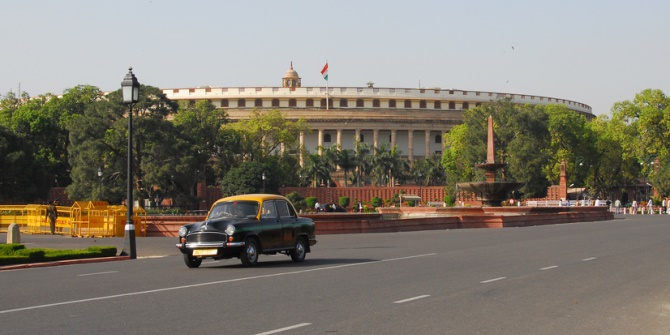
The Indian health sector is not getting the attention it needs. The heavily skewed doctor-patient ratio and the low budget allocations being made by the government are the principal indicators of this fact. Ananye Krishna explores the reasons behind this ratio and what can be done to improve medical care and the training of India’s future medical care providers.
The Indian health sector is obviously not getting the attention it needs. The heavily skewed doctor-patient ratio and the low budget allocations being made by the government are the principal indicators of this fact. While the standard doctor patient ratio as provided by WHO is 1:1000, in India this ratio is at around 1:1668, although possibly this does not account for all the quacks sprawling the streets of India. This low ratio can be directly connected to the low health care spending in India. Currently at 4.69% of its GDP, India has one of the lowest health care spending all over the world and this obvious lack of financial support has led to a lack of medical colleges (thus the poor ratio), hospitals, and finally, a lack of proper facilities in the institutes which already exist.
The consequence of this state of affairs is extremely poor health care which is exemplified by the deaths of 60 infants in a hospital in Gorakhpur, Uttar Pradesh in the month of August because of the lack of oxygen cylinders. Whilst more recently, a live baby was declared dead in a private hospital in the capital of the country.
Although the government’s attention is being drawn to this issue, the root of the problem is that there aren’t enough medical colleges and those which are there are not up to the mark. Consequently, neither does India have doctors nor does it have good doctors. The total number of medical colleges in India is just 479 with a total of around 64000 students and the number of engineering colleges is almost 3500 being home to almost 1.5 million students. Juxtaposing these statistics, one becomes painfully aware of the sorry state of the Indian youth who are trapped in the field of engineering which is badly saturated, while there is literally a drought of medical professionals.
Also, it is important to keep note of the fact, that the Indian objective should not be limited to reach the standard ratio of 1:1000 because that is actually just a border line. India needs to do much better than that, and look for sources of inspiration in this field, for instance, a country like Cuba where the ratio is around 1:140. To achieve its objective, the first step India will have to take is to improve the budgetary allocation. With the improved budgetary allocation the number of colleges will have to be increased and the standards of the existing ones will have to be improved.
One factor other than the financial constraints which inhibits the growth medical education in India is the lack of teachers. To overcome this obstacle, the medical students will have to be incentivised to enter into teaching, and to further this it will also be required to have many more post-graduation seats than there are at present. The most lucrative incentive for the medicos would be a respectable amount of pay and humane work hours, if possible a teaching doctor should not be burdened with clinical work but that doesn’t mean that the practical experience should be completely taken away from them, it should just be a choice.

People queue for a clinic in Kolkata. Image source: CC BY-SA 3.0 .
With time if the ratio does improve it will not only help the people to have better access to healthcare, but it will also improve the amount of working hours for doctors to a great extent. Presently many of the doctors have to work for more than 100 hours a week and at times it may also happen that they have to work 72 hours at a stretch. The unfairness of this situation becomes fully realised when the judgements of the supreme court are brought into picture. In a judgement from 1987 for instance, it has been clarified that a resident doctor should not be made to work for more than 48 hours a week and never more than 12 hours at a stretch. Other than this there doesn’t seem to be any formal law which provides for the appropriate working hours for medical professionals like the Factories Act of 1948 provides for the factory workers.
Such working hours are a titanic burden which is being imposed on a few individuals in the society, and when in such strained circumstances a doctor commits a mistake, accusations of guilt and incompetency are placed upon the individual, without a question being raised against the administrative fault which lies at the root of all this. A major example of such a scenario was the attack on the doctors in Maharashtra in March this year.
It would be unfair to suggest that the government is completely oblivious to the problem as it has increased the budget for the health sector by 23%, established two more AIIMS (All India Institute of Medical Sciences) and has promised to increase the post-graduation seats by 5000 every year. There is still however, a need for developing a structure which will incentivise a greater number of young doctors to join the academia in India, the infrastructure will have to be improved and a promise of adequate financial stability by the government is much needed considering that lack of these has been driving young graduates away from India.
There is also a need to further increase the budget for health sector so that the existing medical colleges can accommodate more students and have access to better facilities during their training period. Although there is also an urgent need to formulate and enforce rules providing humane working hours for the doctors, the same won’t actually become enforceable before the doctor patient ratio is improved. If the government is willing to take these steps, then it will have a huge impact on the overall socio-economic scene in India. A populace not burdened by disease and overwork is crucial for the development of the nation.
This article gives the views of the authors, and not the position of the South Asia @ LSE blog, nor of the London School of Economics. Please read our comments policy before posting.
About the Author

Ananye Krishna is a third year student at NALSAR University of Law, Hyderabad. He has been engaged in writing about socio-economic rights and is also a part of an NGO (DEVISE) which teaches underprivileged children. He has previously written about the impact of linking Aadhaar Card with Mid Day Meal scheme in the LSE South Asia blog and violence against doctors in India in the LSE Human Rights Blog.







